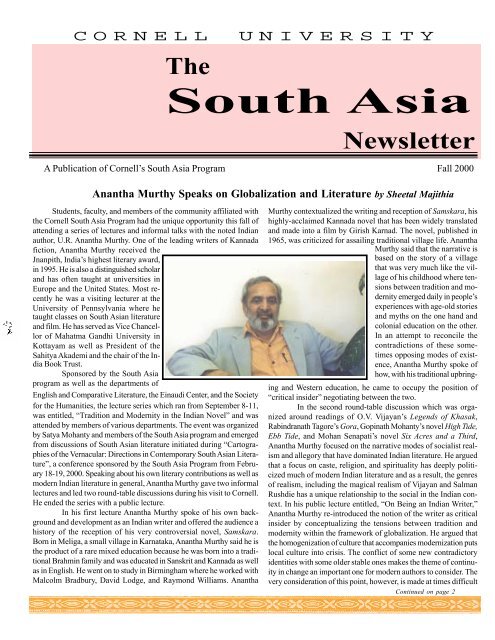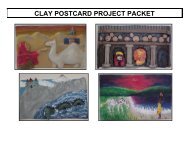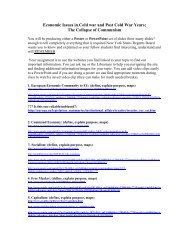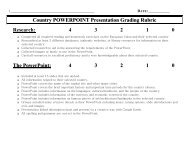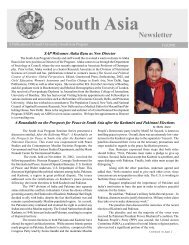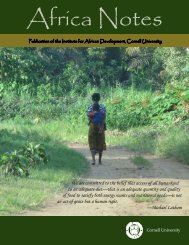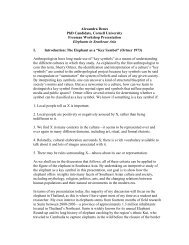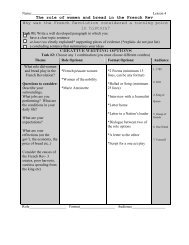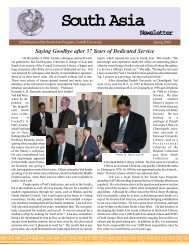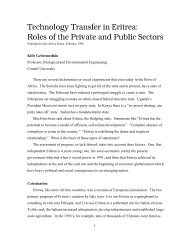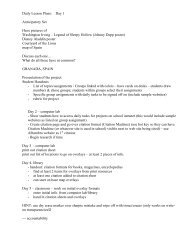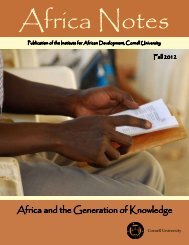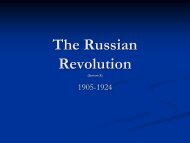Fall 2000 - South Asia Program - Cornell University
Fall 2000 - South Asia Program - Cornell University
Fall 2000 - South Asia Program - Cornell University
Create successful ePaper yourself
Turn your PDF publications into a flip-book with our unique Google optimized e-Paper software.
C O R N E L L<br />
U N I V E R S I T Y<br />
The<br />
<strong>South</strong> <strong>Asia</strong><br />
Newsletter<br />
A Publication of <strong>Cornell</strong>’s <strong>South</strong> <strong>Asia</strong> <strong>Program</strong> <strong>Fall</strong> <strong>2000</strong><br />
Anantha Murthy Speaks on Globalization and Literature by Sheetal Majithia<br />
Students, faculty, and members of the community affiliated with<br />
the <strong>Cornell</strong> <strong>South</strong> <strong>Asia</strong> <strong>Program</strong> had the unique opportunity this fall of<br />
attending a series of lectures and informal talks with the noted Indian<br />
author, U.R. Anantha Murthy. One of the leading writers of Kannada<br />
fiction, Anantha Murthy received the<br />
Jnanpith, India’s highest literary award,<br />
in 1995. He is also a distinguished scholar<br />
and has often taught at universities in<br />
Europe and the United States. Most recently<br />
he was a visiting lecturer at the<br />
<strong>University</strong> of Pennsylvania where he<br />
taught classes on <strong>South</strong> <strong>Asia</strong>n literature<br />
and film. He has served as Vice Chancellor<br />
of Mahatma Gandhi <strong>University</strong> in<br />
Kottayam as well as President of the<br />
Sahitya Akademi and the chair of the In-<br />
dia Book Trust.<br />
Sponsored by the <strong>South</strong> <strong>Asia</strong><br />
program as well as the departments of<br />
English and Comparative Literature, the Einaudi Center, and the Society<br />
for the Humanities, the lecture series which ran from September 8-11,<br />
was entitled, “Tradition and Modernity in the Indian Novel” and was<br />
attended by members of various departments. The event was organized<br />
by Satya Mohanty and members of the <strong>South</strong> <strong>Asia</strong> program and emerged<br />
from discussions of <strong>South</strong> <strong>Asia</strong>n literature initiated during “Cartographies<br />
of the Vernacular: Directions in Contemporary <strong>South</strong> <strong>Asia</strong>n Literature”,<br />
a conference sponsored by the <strong>South</strong> <strong>Asia</strong> <strong>Program</strong> from February<br />
18-19, <strong>2000</strong>. Speaking about his own literary contributions as well as<br />
modern Indian literature in general, Anantha Murthy gave two informal<br />
lectures and led two round-table discussions during his visit to <strong>Cornell</strong>.<br />
He ended the series with a public lecture.<br />
In his first lecture Anantha Murthy spoke of his own background<br />
and development as an Indian writer and offered the audience a<br />
history of the reception of his very controversial novel, Samskara.<br />
Born in Meliga, a small village in Karnataka, Anantha Murthy said he is<br />
the product of a rare mixed education because he was born into a traditional<br />
Brahmin family and was educated in Sanskrit and Kannada as well<br />
as in English. He went on to study in Birmingham where he worked with<br />
Malcolm Bradbury, David Lodge, and Raymond Williams. Anantha<br />
Murthy contextualized the writing and reception of Samskara, his<br />
highly-acclaimed Kannada novel that has been widely translated<br />
and made into a film by Girish Karnad. The novel, published in<br />
1965, was criticized for assailing traditional village life. Anantha<br />
Murthy said that the narrative is<br />
based on the story of a village<br />
that was very much like the village<br />
of his childhood where tensions<br />
between tradition and modernity<br />
emerged daily in people’s<br />
experiences with age-old stories<br />
and myths on the one hand and<br />
colonial education on the other.<br />
In an attempt to reconcile the<br />
contradictions of these sometimes<br />
opposing modes of existence,<br />
Anantha Murthy spoke of<br />
how, with his traditional upbringing<br />
and Western education, he came to occupy the position of<br />
“critical insider” negotiating between the two.<br />
In the second round-table discussion which was organized<br />
around readings of O.V. Vijayan’s Legends of Khasak,<br />
Rabindranath Tagore’s Gora, Gopinath Mohanty’s novel High Tide,<br />
Ebb Tide, and Mohan Senapati’s novel Six Acres and a Third,<br />
Anantha Murthy focused on the narrative modes of socialist realism<br />
and allegory that have dominated Indian literature. He argued<br />
that a focus on caste, religion, and spirituality has deeply politicized<br />
much of modern Indian literature and as a result, the genres<br />
of realism, including the magical realism of Vijayan and Salman<br />
Rushdie has a unique relationship to the social in the Indian context.<br />
In his public lecture entitled, “On Being an Indian Writer,”<br />
Anantha Murthy re-introduced the notion of the writer as critical<br />
insider by conceptualizing the tensions between tradition and<br />
modernity within the framework of globalization. He argued that<br />
the homogenization of culture that accompanies modernization puts<br />
local culture into crisis. The conflict of some new contradictory<br />
identities with some older stable ones makes the theme of continuity<br />
in change an important one for modern authors to consider. The<br />
very consideration of this point, however, is made at times difficult<br />
Continued on page 2
A Publication of <strong>Cornell</strong>’s <strong>South</strong> <strong>Asia</strong> <strong>Program</strong><br />
NOTES FROM THE DIRECTOR<br />
Dear Colleagues and Friends of the <strong>South</strong> <strong>Asia</strong> <strong>Program</strong>:<br />
I am happy to report that <strong>Cornell</strong>’s <strong>South</strong> <strong>Asia</strong> <strong>Program</strong> once again won Title VI funding<br />
from the Department of Education in the National Resource Center competition, as part of the<br />
<strong>Cornell</strong>-Syracuse consortium. The funding enables us to continue many of our ongoing activities<br />
and start up new ones on campus and in outreach beyond campus. The NRC will enable us<br />
to co-sponsor two new courses by Dede Ruggles on “Islamic Architecture: Form and Context”<br />
(Arch 399), and “Landscape and Architecture in Moghul <strong>South</strong> <strong>Asia</strong>” (<strong>Asia</strong>n 494 ), both of which<br />
will be taught in the upcoming spring semester. NRC funds enable us to search for a visiting<br />
Environmental Historian of <strong>South</strong> <strong>Asia</strong>, who will come for one semester in each of the next two<br />
academic years.<br />
With the beginning of a new year we welcome the arrival to campus of new colleagues with<br />
research and/or teaching interests in <strong>South</strong> <strong>Asia</strong>. First and foremost we welcome Dr. Mehr<br />
Farooqi, who joins us as our Lecturer in Hindi-Urdu (See Faculty page). Mehr has already<br />
contributed significantly to our <strong>Program</strong>’s activities, and we look forward to working with her to<br />
build up Hindi and Urdu instruction in the coming year. We also welcome Andrew Willford,<br />
Anthropology, who works on Tamil-speaking groups in <strong>South</strong> <strong>Asia</strong> and in <strong>South</strong>east <strong>Asia</strong>,<br />
Shawkat Toorawa, Near Eastern Studies (see Faculty Page), and Madhav Ghimire, Joint Secretary,<br />
Ministry of the Environment, Nepal, who comes to <strong>Cornell</strong> as a Humphrey Fellow for the<br />
academic year <strong>2000</strong>/2001.<br />
We have already had U.R. Anantha Murthy come to campus for a two-week visit (see front<br />
page). As always we continue to bring artists and performers to campus (see Fine Arts page). In<br />
addition, the SAP offices have recently been redecorated with photographs by Barry Perlus. The<br />
Directors office, in particular, is now a showroom for a series of Sawai Jaisingh’s Jantar Mantar.<br />
I recently spent a month in the Palace Museum in Jaipur as part of a team cataloging Jaisingh’s<br />
collection of astronomy manuscripts, so these striking photographs have a special meaning for<br />
me. I invite you all to come by and see them when you are next in Uris Hall.<br />
Sincerely,<br />
Christopher Minkowski<br />
Director, <strong>South</strong> <strong>Asia</strong> <strong>Program</strong><br />
Ananta Murthy con’t.<br />
by the threat that English poses to the other Indian vernacular languages. Anantha Murthy<br />
argued that though many Indian vernacular languages face the possibility of being replaced<br />
by English, historically they have always produced new literature in opposition to the high<br />
literary tradition of Sanskrit and will continue to do the same in the face of the rapid spread<br />
of English. Using the spatial metaphor of language as a house, he argued that whereas<br />
vernacular languages once served as a backyard to Sanskrit, the front yard, they might now<br />
serve as the backyard to English. He was hopeful about the continuity of Indian vernacular<br />
literary traditions arguing that they will persist because languages are places where one can<br />
hide from the nightmares of globalization.<br />
Student Organizations<br />
and Presidents<br />
ASHA<br />
Venkatasubramanian Narayanan<br />
vn23@cornell.edu<br />
254-6329<br />
Bangladesh Association<br />
Itrat Sayeed<br />
is38@cornell.edu<br />
253-6116<br />
Bhakti (Hindu Organization)<br />
Krishna Maheswari<br />
kkm9@cornell.edu<br />
253-2815<br />
<strong>Cornell</strong> India Association (CIA)<br />
Swaroop Kommera<br />
swar@ee.cornell.edu<br />
277-3292<br />
Muslim Educational/Cultural<br />
Association (MECA)<br />
Omar Bajwa<br />
osb4@cornell.edu<br />
253-5497<br />
Nepal Student Association<br />
Leah Mayor<br />
lem15@cornell.edu<br />
Pakistani Student Association<br />
(AWAAZ)<br />
Reza Samad<br />
rs229@cornell.edu<br />
227-5156<br />
Mehreen Yousaf<br />
my36@cornell.edu<br />
272-4523<br />
Sitara (Dance Troupe)<br />
Lavanya Kilaru<br />
lk46@cornell.edu<br />
253-0933<br />
Apra Bhandari<br />
ab115@cornell.edu<br />
253-0876<br />
Society for India at <strong>Cornell</strong> (SICU)<br />
Sandeep Rao<br />
spr9@cornell.edu<br />
253-7048<br />
Society for the Promotion of<br />
Indian Classical Music andCulture<br />
Among Youths<br />
(SPICMACAY)<br />
Sowmya Varadharajan<br />
sv49@cornell.edu<br />
254-6369<br />
2
outreach<br />
<strong>Fall</strong> <strong>2000</strong><br />
New Resources for Teaching about <strong>South</strong> <strong>Asia</strong><br />
Gandhi: Apostle of Peace and Nonviolence A multimedia CD-ROM that depicts the life and message of Mahatma Gandhi. Includes 45 minutes<br />
of movie clips, 200 photos, letters and an interactive time line.<br />
INDIA <strong>2000</strong> This CD-ROM Reference Annual contains information on diverse aspects of the country, from the geographic and demographic<br />
features to polity, economy and culture. Produced by the Ministry of Information and Broadcasting, Government of India.<br />
Fact Sheets produced by the Indian Government on US-Indian relations<br />
Visit of the US President to India chronicles the historic visit of President Clinton to India, March 19 - 25, <strong>2000</strong> and includes speeches and<br />
interviews in their entirety.<br />
Other Outreach Materials for K-12 and Post-secondary Educators<br />
Come with Me to India<br />
Elementary Social/Global Studies<br />
A Wondrous voyage through time, as presented by author, Sudha Koul. Gives an elementary overview of India on subjects including cuisine,<br />
religion, educational system and environment.<br />
Global Studies Series: India and <strong>South</strong> <strong>Asia</strong>, First and Third Editions<br />
Secondary: Social/Global Studies<br />
Collected articles from various scholars of the area. Provides a foundation of information–geographic, cultural, economic, political, historical,<br />
artistic and religious–which allows for better understanding of the current and future problems associated with the countries of the region.<br />
Elementary School Teachers Guide<br />
Elementary, Compiled by the <strong>South</strong> <strong>Asia</strong> <strong>Program</strong>, <strong>Cornell</strong> <strong>University</strong><br />
General information on <strong>South</strong> <strong>Asia</strong>. Specific activities for elementary school age children, including games, food and other activities to<br />
coordinate with the Aditi box and Nepali basket.<br />
From <strong>South</strong> to <strong>South</strong>east: An <strong>Asia</strong>n Journey of the Epic Mahabharata<br />
K-12 Global/Social studies teachers, compiled by the <strong>South</strong> and <strong>South</strong>east <strong>Asia</strong> <strong>Program</strong>s, <strong>Cornell</strong> <strong>University</strong><br />
Provides for a comparative study of these world areas focusing on the Hindu i epic, Mahabharata and how each country interprets the story.<br />
Other activities include making shadow puppets (wayang) and an introduction to the Javanese music Gamelan as well as how dharma<br />
(roughly: duty) governs characters of the story.<br />
Flexible Borders: Nationalism, Citizenship and Migration<br />
High School Global/Social studies teachers, compiled by the Area Studies <strong>Program</strong>s, <strong>Cornell</strong> <strong>University</strong><br />
Provides articles and references for curriculum development on the following topics: “Ethnic Conflict and National Identity in Sri Lanka”,<br />
“Criss-Crossing the U.S. Mexican Border”, “Violence in the Construction and Identity of Community: The Case of Bosnia”, and “Long-Distance<br />
Nationalism of East and <strong>South</strong>east <strong>Asia</strong>”<br />
Mahabharata<br />
Dreamland Publications Comic books. 12 parts.<br />
This series uses comics to tell the story of two sets of cousins, the Kauravas and the Pandavas, who fight over succession to the throne.<br />
Ramayana<br />
Dreamland Publications Comic books. 12 parts.<br />
This series tells the story of Rama and his wife Sita.<br />
Continued on back page<br />
3
Prelude to Political Economy, A Study of<br />
the Social and Political Foundations of Economics<br />
(Oxford <strong>University</strong> Press, October, <strong>2000</strong>), by<br />
<strong>Cornell</strong>’s Department of Economics Professor,<br />
Kaushik Basu, is a critique of economics as social<br />
science. This is unusual because it uses many of<br />
the same techniques that contemporary economics<br />
and positive political economy use. It relies<br />
on game theory, and more importantly, on<br />
game-theoretic reasoning; but the technical demands<br />
are small. The book cautions that perhaps<br />
we are trying to move too fast; that we are, mistakenly,<br />
dismissive of ideas that cannot be fully formalized, and too glib with<br />
our elegant tools of analysis. It must be recognized that markets and the<br />
economy are embedded in society, politics, and the law; and an immense<br />
amount of research has to go into understanding the nature of this embedding<br />
before we can come out with reliable answers. Prelude to Political Economy<br />
suggests a new approach to law and economics and to the state, and addresses<br />
important questions such as whether the state should guarantee<br />
freedom of speech and whether the free market can lead to coercion.<br />
Modern Economics recognizes that individuals’ pursuit of their<br />
own selfish ends can result in socially suboptimal outcomes–the Prisoner’s<br />
Dilemma being the stark example. It has been suggested that what we need<br />
in such an eventuality is ‘third party’ intervention, which can take the form<br />
of imposing punishment on players. Kaushik Basu objects to this method of<br />
wishing third parties out of thin air. He argues that if a third party that could<br />
impose its will on others were available, then it should have been modeled as<br />
a player to start with.<br />
The adoption of such an inclusive approach has implications for<br />
our conception of the state and the law. It means that the law cannot be<br />
construed as a factor that changes the game that citizens play. It is instead<br />
simply a set of beliefs of citizens; and as such, it is similar to social norms.<br />
What the law does for an economy, so can social norms. The book discusses<br />
how the nature of policy advice and our conception of state power are<br />
affected by this altered view of the state and the law.<br />
4<br />
Prelude to Political Economy<br />
The walls of the <strong>South</strong> <strong>Asia</strong> <strong>Program</strong> Offices<br />
are currently graced with a collection of framed<br />
photographs of architectural subjects from India<br />
and Nepal. The photographs, made by Associate<br />
Professor of Art Barry Perlus, are selected from<br />
his exhibition Made of Light: Photographs from<br />
India and Nepal, which was shown in 1991 and<br />
1992 at the MIT Museum and several other<br />
college museums and galleries. The exhibition<br />
included photographs of temples and sculpture<br />
from Ellora and Mamallapuram, India, the<br />
masonry observatories, “Jantar Mantar” built in<br />
the early 1700’s in New Delhi and Jaipur by Jai<br />
Singh II, and a mixture of sacred and secular<br />
architecture in Nepal. Photographs of the<br />
observatory at Delhi were published as a portfolio<br />
in Parabola No. 15 Time and Presence.<br />
More recently, Perlus traveled to Delhi and<br />
Bombay with colleagues from the College of<br />
Faculty<br />
SAP Displays Photographs by Barry Perlus<br />
God-Apes and Fossil Men:<br />
Paleoanthropology of <strong>South</strong> <strong>Asia</strong><br />
This book provides the first comprehensive<br />
study of the ancient peoples of <strong>South</strong><br />
<strong>Asia</strong>. Until recently the scientific study of the<br />
prehistoric peoples of India, Pakistan, Sri Lanka,<br />
and the <strong>South</strong> <strong>Asia</strong>n borderlands has been neglected,<br />
beyond some cursory comments in the<br />
popular literature about archaeological discoveries.<br />
Here is a book that offers much more: a broad<br />
survey of all prehistoric cultures of the Indian<br />
subcontinent from Paleolithic to Iron Age times.<br />
Written in a style accessible to the general<br />
reader, the book pioneers a new approach<br />
involving the integration of data from archaeological, paleontological, ecological,<br />
and anthropological investigations to offer a comprehensive picture of the<br />
origins, diversity, and lifeways of southern <strong>Asia</strong>n populations. Complex scientific<br />
ideas are clearly and carefully explained in early chapters as the author<br />
considers the theories of human origins in <strong>Asia</strong> and the significance of the<br />
fossils of anthropoid apes recovered from the Siwalik hills (the "God-Apes").<br />
Thereafter the text carries the story of human life on the subcontinent through<br />
distinct cultural periods from the Paleolithic to the Iron Age.<br />
Over the course of the book Kenneth A. R. Kennedy demonstrates<br />
that <strong>South</strong> <strong>Asia</strong>n paleoanthropology has been formed by two intellectual<br />
forces: Western scientific traditions and native Vedic traditions. The interactions<br />
of Western and <strong>South</strong> <strong>Asia</strong>n scholars have produced a unique approach<br />
to the study of ancient populations in this part of the world.<br />
No other book exists today on this subject, and God-Apes and<br />
Fossil Men: Paleoanthro-pology of <strong>South</strong> <strong>Asia</strong> serves as a model for future<br />
studies of ancient peoples and places.<br />
Kenneth A. R. Kennedy is Professor of Ecology, Anthropology, and<br />
<strong>Asia</strong>n Studies in the Division of Biological Sciences, <strong>Cornell</strong> <strong>University</strong>. He<br />
has over thirty-five years of field and laboratory research in India, Pakistan,<br />
Sri Lanka, and the borderlands. (Taken from http://www.press.umich.edu/titles/<br />
11013.html)<br />
Column detail with seated figure,<br />
Cave 29, Ellora, India,<br />
by Barry Perlus<br />
Architecture, Art<br />
and Planning as<br />
part of an interdisciplinary<br />
effort to<br />
develop working<br />
relationships with<br />
academics and<br />
professionals in<br />
the field of historic<br />
architectural<br />
interpretation of<br />
these sites.<br />
Catalogs of<br />
the Made of Light<br />
exhibition and further<br />
information<br />
about the observatories<br />
are available at the <strong>South</strong> <strong>Asia</strong> <strong>Program</strong><br />
office.<br />
SAP Seminar Introduces<br />
Shawkat Toorawa<br />
In July of this year, Shawkat M. Toorawa<br />
joined the Department of Near Eastern<br />
Studies as Assistant Professor of Arabic<br />
Literature and Islamic Studies. In 1999/<strong>2000</strong><br />
he was a Rockefeller African Humanities<br />
Institute Fellow at the W. E. du Bois Institute,<br />
Harvard <strong>University</strong>. From 1996 to <strong>2000</strong> he<br />
was Lecturer in History in the Department of<br />
Humanities at the <strong>University</strong> of Mauritius.<br />
In September, Shawkat gave a talk,<br />
Where women grow on trees: Fabulous<br />
Indian Ocean Islands, in the <strong>South</strong> <strong>Asia</strong><br />
<strong>Program</strong> seminar series on one of his Indian<br />
Ocean interests, the islands of Waqwaq. His<br />
article, “Waq al-waq: Fabulous, Fabular<br />
Continued on oppostie page, column one
Faculty Briefs<br />
Kaushik Basu, Department of Economics, had two major works published<br />
recently, Prelude to Political Economy, Oxford <strong>University</strong> Press, October, 200<br />
(see page 4), and “Whither India The Prospect of Prosperity,” in India,<br />
Another Millennium, edited by Romila Thapar, Viking, July, <strong>2000</strong>.<br />
Durga Bor attended an Odissi dance workshop given by Padmabhushan<br />
Kelucharan Mohapatra in Washington, D.C., followed by a three-day conference<br />
and festival of Odissi. She performed for Hamilton College’s annual Diwali<br />
Festival in October as well as in Tina Croll’s and Jamie Cunningham’s “From<br />
the Horses Mouth,” at the Clemens Center, Elmira, November 4.<br />
Ron Herring, Department of Government and Director, Einaudi Center for<br />
International Studies, attended the conference on “Institutional Reform and<br />
Poverty Reduction” at the London School of Economics and the “International<br />
Conference on Biotechnology and Globalization” at the Kennedy School<br />
of Government, Harvard <strong>University</strong>. Carrots, Sticks and Ethnic Conflict: Rethinking<br />
Development Assistance, edited by Milton Esman and Herring, will be<br />
available this Winter from the <strong>University</strong> of Michigan Press, Ann Arbor. This<br />
also includes a chapter by <strong>Cornell</strong>’s Norman Uphoff, on the “Gal Oya Project<br />
in Sri Lanka,” in which a foreign aid project (and <strong>Cornell</strong> <strong>University</strong>) helped in<br />
producing not only more grain but an island of ethnic peaces in escalating war.<br />
Ron contributed a darker companion chapter on the contributions of foreign<br />
aid to ethnic war in Sri Lanka.<br />
Mary Katzenstein gave a paper, “The Mother and the State in India:<br />
Reproductive Health in India,” at a symposium in memory of the late Professor<br />
Myron Weiner which will be published in November’s <strong>Asia</strong>n Survey, a special<br />
issue which is a tribute to the Professor Weiner. Mary’s term with the Executive<br />
and Selection Committees of the American Institute of Indian studies has recently<br />
come to an end.<br />
Kenneth A. R. Kennedy, Departments of Ecology, Anthropology, and <strong>Asia</strong>n<br />
Studies in the Division of Biological Sciences, has published God-Apes and<br />
Fossil Men: Palaeoanthropology of <strong>South</strong> <strong>Asia</strong>, <strong>University</strong> of Michigan Press,<br />
<strong>2000</strong>, (see page 4). He has recently published the following articles: “Activity,<br />
Climate and Postgranial Robusticity: Implications for Modern Human Origins,”<br />
in Osbojorn M. Pearson’s Current Anthropology; “Preparing a History of the<br />
American Association of Physical Anthropologists,” in Abstracts of the Annual<br />
Meeting of the American Association of Physical Anthropologists; “Forensic<br />
Anthropology in the United States,” in Encyclopedia of Forensic Sciences;<br />
“Porotic Hyperostosis in Prehistoric Skeletons from <strong>South</strong> <strong>Asia</strong>,” in Man-<br />
Environment Relationships; Review of Stehpanie Moser’s “Ancestral Images,”<br />
Isis. Kenneth attended the annual meeting of the Society for Harappan Studies<br />
held in Manchester, Vermont in August, and has given lectures in several of the<br />
SAP faculty’s classes. In November he gave a paper, “Biological Anthropology<br />
in <strong>South</strong> <strong>Asia</strong> in the 21st Century,” which was for the American Anthropological<br />
Association’s annual meeting in San Francisco.<br />
Michael Latham, Professor of International Nutrition was in Bangladesh<br />
from July 20-28 where he serves on Advisory Committee of BRAC. The<br />
Research and Evaluation Division of BRAC is launching a new project based on<br />
work that Dr. Latham undertook in Tanzania. The BRAC project aims to<br />
improve the nutritional status of adolescent girls in poor communities.<br />
David Lelyveld presented a paper “The Tables Turned: Colonial Knowledge<br />
and Muslim Consciousness in Nineteenth Century India” for Panel on Institutional<br />
Histories, Colonial Knowledges: the Scholarly vision of Bernard S.<br />
Cohn, (American Ethnological Society, Society for Cultural Anthropology),<br />
American Anthropological Association, Annual Meeting, November 17, <strong>2000</strong>,<br />
San Francisco.<br />
Norman Uphoff, CIIFAD, participated in a conference sponsored by The<br />
Food Systems for Improved Health <strong>Program</strong> November 25 in Dhaka on “Improving<br />
Health and Economic Development: Approaches to Preventing Diet-<br />
Related Rickets”. He contributed a chapter to Carrots, Sticks and Ethnic<br />
Conflict: Rethinking Development Assistance (see above).<br />
Toorawa con’t.<br />
Indian Ocean ()... Islands”, in Emergences, vol. 10, no. 2 (December<br />
<strong>2000</strong>), pp. 387-402, has just appeared. His article on “Waqwaq” in<br />
vol. 11 of the Encyclopedia of Islam is in press.<br />
SAP Welcomes Mehr Farooqi as<br />
Hindi/Urdu Lecturer<br />
The <strong>South</strong> <strong>Asia</strong> <strong>Program</strong> would like to extend a warm welcome<br />
to Dr. Mehr Farooqi, who was appointed by the Department of <strong>Asia</strong>n<br />
Studies this <strong>Fall</strong> as Lecturer for Hindi-Urdu language. Dr. Farooqi<br />
comes to us from the <strong>University</strong> of Pennsylvania, where she taught<br />
Hindi-Urdu since 1998. She also taught Urdu and Persian language<br />
and literature and <strong>South</strong> <strong>Asia</strong> medieval history there from 1995-1996.<br />
She has done both undergraduate and graduate studies at Allahabad<br />
<strong>University</strong> in India and has numerous publication translations to her<br />
credit. She is currently working on an analytical introduction, edition<br />
and translation of the Candayan of Maulana Da’ud in Awadhi. This<br />
research is funded by the National Endowment for the Humanities<br />
and the American Institute of Indian Studies.<br />
<strong>Cornell</strong> Graduate Joins <strong>University</strong><br />
of Wisconsin-Madison Faculty<br />
Congratulations to Aseema Sinha, a <strong>Cornell</strong> <strong>University</strong><br />
Ph.D. graduate (class of <strong>2000</strong>), who has recently joined the faculty of<br />
the Political Science Department at the <strong>University</strong> of Wisconsin-<br />
Madison. Her education began in India, where she received a<br />
Bachelor of Arts degree from Lady Shri Ram College, New Delhi, and<br />
a Masters degree from Jawaharlal Nehru <strong>University</strong>, New Delhi, both<br />
in political science. Her masters thesis was on “Antonio Gramsci’s<br />
Concept of National-Popular Will.” She went on to receive a second<br />
masters degree in 1997 at <strong>Cornell</strong>, and subsequently became a Ph.D.<br />
candidate in the Department of Government, with a dissertation titled,<br />
“Divided Leviathan: Comparing Sub-national States in India,” which<br />
re-examines India’s developmental state and suggests that a<br />
national-level characterization of India as a “failed state” masks very<br />
significant regional divergence in developmental patterns across<br />
Indian states. The dissertation insists that this mis-specification of<br />
the level of analysis leads to an inaccurate reading of India. Her<br />
analysis of three provinces within India -- Gujarat, West Bengal and<br />
Tamil Nadu -- shows that some provinces developed “strategic<br />
capacities” which were instrumental in reorienting market processes<br />
towards development. She also emphasized that states operate<br />
within a two-tiered federal system and the type and the extent of<br />
competition in a federal system affects the developmental output of<br />
nation-states.<br />
In the Spring of <strong>2000</strong> Aseema taught two courses at<br />
Madison entitled Introduction to Comparative Politics and a seminar<br />
class on the Politics of <strong>South</strong> <strong>Asia</strong>. This <strong>Fall</strong> she is teaching a course<br />
titled The Third World and International Development and another<br />
on Comparative Social Movements; both courses having material on<br />
<strong>South</strong> <strong>Asia</strong>. In the near future she hopes to develop a new course on<br />
<strong>South</strong> <strong>Asia</strong> and International Relations, as well as teach the graduate<br />
seminar on Politics of Developing Areas. She also plans on being<br />
involved with a re-activated seminar series at the Center of <strong>South</strong><br />
<strong>Asia</strong> at Madison, as well as a conference on Democratization in <strong>South</strong><br />
<strong>Asia</strong>.<br />
Continued on back page<br />
5
Fine arts<br />
A Different Kind of Globalization<br />
Instead of focusing exclusively on <strong>South</strong> <strong>Asia</strong>n music or dance this semester, SAP<br />
decided to ask other area-studies programs and departments for their support and collaboration<br />
in order to present Global Rhythms and the World Music Ensemble on October 21, <strong>2000</strong>, in the<br />
Statler Auditorium. This resulted in a three-hour long celebration of featured artists from around<br />
the world who were backed by a student orchestra provided by Miami <strong>University</strong> (Ohio). The<br />
evening opened with nine-year-old prodigy, Kiran Pathakota, whose spellbinding performance<br />
on the mridangam made him a hard act to follow. Other featured artists included Kiran’s father,<br />
Sathish Pathakota, who was introduced as a “mathematical genius” with tal, playing mridangam<br />
as well as Kanjira. Additional representatives of <strong>South</strong> <strong>Asia</strong> were Anupama Sharma, who presented<br />
a sitar solo, Narasimha Kikkerji on violin, and Pat Hernly on ghatam.<br />
Grammy-winning frame drum expert, Glen Velez, produced complex sounds from his<br />
Irish bodhran, as well as his vocal chords, as he sang overtones, winning him a standing<br />
ovation. Eguie Castrillo, conga maestro and Professor at Berklee College of Music, entertained<br />
the audience with his rhythms and his keen sense of humor. John Santos played on a variety of<br />
percussion instruments, with an emphasis on Afro-Latin Rhythms. Min Xiao-Fen changed the<br />
Nine-year-old Kiran Pathakota<br />
mood with the delicate sounds of the Chinese pipa, an ancient lute, which she played with great<br />
mastery. Representing the Middle East were Yunus Ashraf on the Afghani rabab, producing haunting melodies in the classical tradition,<br />
followed by Klezmer music performed by Michele Gingras on clarinet and Josh Moss on piano. Michele’s energy and virtuosity were truly<br />
astounding. Carrie Marchner both sang and played Bosnian folk songs on the flute with soulful skill and beauty.<br />
The evening ended with an upbeat orchestration of Latin rhythms and melodies which had the audience dancing in the aisles, with<br />
featured artists Ariel Kahn and Raphael Flores representing Brazil, and Jaime Morales-Matos playing Latin Jazz Trombone.<br />
This evening would not have been possible if it weren’t for Srinivas Krishnan, director of Global Rhythms and the World Music<br />
Ensemble, and a master tabla player in his own right, who performed as both soloist and accompanist throughout the evening. Srini’s great<br />
enthusiasm and networking skills helped to bring this diverse and talented group of artists to the attention of the <strong>South</strong> <strong>Asia</strong> <strong>Program</strong>. At the<br />
age of 21 Srini was featured in the USA at the <strong>University</strong> of North Texas. Srini has performed on the tabla with some of India’s great artists such<br />
as Dr. L. Subramaniam and Ustad Bismillah Khan. He has been a featured percussionist (tabla, bodhran and snare drum) at Interlochen, CCM,<br />
Indiana <strong>University</strong>, UCLA, Oberlin Conservatory, <strong>University</strong> of Washington, MIT, Dartmouth, and West Virginia <strong>University</strong>. He has been a<br />
featured artist and recorded on projects with members of the Berlin Philharmonic, Sting, Remo Inc, and on Grammy-winning Label, Water Lily<br />
Acoustics. He has recently performed with artists of Real World and has scored background music for several films. Srini has been trained in<br />
different styles of music from various scholars and has spearheaded efforts for Miami <strong>University</strong> in receiving several grants for major projects.<br />
He has served as Director of America Direct Academic Foundation in India.<br />
SPICMACAY Sponsors the Priya Sisters by Sowmya Varadharajan<br />
November 3 rd gave the <strong>Cornell</strong> community an opportunity to listen to one<br />
of the greatest Carnatic concerts ever performed. The Priya sisters,<br />
Shanmukhapriya and Haripriya were accompanied by Sri B. V. Raghavendra<br />
Rao (on the violin) and Sri J. Vaidynathan (on the mridangam). The three-hour<br />
concert commenced with a speedy varnam, that set the mood for the night. The<br />
main song for their performance was Meenakshi in Raag Poorvikalyani in which<br />
they demonstrated their creativity through their elaborate swara kalpanas. Sri<br />
B. V. Raghavendra Rao’s nimble fingers delivered melodious notes on the violin.<br />
Sri J. Vaidynathan proved to be an apt percussionist in his superb delivery<br />
of thaalam. He proved his prowess in the thani aavarthanam. The concert<br />
came to a close with several thukadaas, which showed their versatility in singing<br />
songs.<br />
This concert was sponsored by SPICMACAY, The Society for the<br />
Promotion of Indian Classical Music and Culture among Youth, and was held at<br />
the Film Forum at <strong>Cornell</strong>’s Center for Theatre Arts.<br />
6
Saadia Toor is a Ph.D. candidate in the field of developmental<br />
sociology, Dept. of Rural Sociology. She is currently in<br />
Pakistan on an Einaudi dissertation grant and a Woodrow Wilson<br />
Women’s Studies Fellowship. She is doing research on the relationship<br />
between the state and national culture in Pakistan during the<br />
1960s and 70s.<br />
Fieldwork is severely over-rated. Any disgruntled graduate<br />
student will agree with this, especially during/after the first few<br />
months of it.<br />
I think the biggest challenge I have faced since arriving in<br />
Lahore last December is something that has little to do with the<br />
actual nitty-gritty of research work. It is my family. Lovely as they<br />
are (and they aren’t all, always) it is still impossible to have any kind<br />
of routine when I am almost always within telephonic reach of aunts,<br />
uncles, grandmothers and the occasional second cousin twice removed.<br />
So my first piece of advice to grad students still in the<br />
process of deciding on a research topic is: avoid the old home country<br />
as a site.<br />
The bright side of returning to work in a city where one has<br />
grown up, is the possibility of rediscovering that with which you<br />
have the best of childhood associations as well as, occasionally, the<br />
thrill of discovering something entirely new and unexpected. Lahore<br />
has been called the cultural heart of Pakistan often enough for it to be<br />
cliché - but it happens to be true. The onward rush of life and traffic,<br />
the mushrooming of consumer culture which characterize third world<br />
cities in the contemporary period, make it appear as if the old Lahore<br />
–of roadside intellectual debate at designated tea stalls in Old Anarkali<br />
Bazaar, impromptu literary expositions, study circles on topics ranging<br />
from philosophy to communism – is dead and buried. After a few<br />
months of hobnobbing with ‘the usual suspects’ of the local cultural<br />
scene – such are the occupational hazards of doing one’s research<br />
on the political economy of culture – I have come to realize that old<br />
litterateurs – and revolutionaries, for that matter – don’t die, they just<br />
debate away. The circle may get smaller and smaller – and unfortunately<br />
it has, given the dumbing down of culture which has occurred<br />
at the state and general level in Pakistan over the last 25 years or so.<br />
Since my work is historical – I am trying to explore the relationship<br />
between culture and the state in Pakistan over the 1958 –<br />
1977 period – and no-one in Pakistan seems to believe in textual<br />
documentation. Historical research has also suffered greatly at the<br />
hands of an authoritarian and ideological state. I have to rely on oral<br />
historical sources rather more than I would like. This means talking<br />
to people who have been in the forefront of various struggles on the<br />
left – who have made and lived through history, as it were – which is<br />
always a thrilling and uplifting experience, especially for a generation<br />
of Pakistanis like me who have been deprived of any but the official<br />
version of their history. Until I joined the Mazdoor-Kissan Party –<br />
Mazdoor Kissan translates as ‘labourers and peasants’ - earlier this<br />
year (how many people get to casually mention joining a Maoist<br />
revolutionary party in their field notes), I had no idea of the extent of<br />
the Left’s influence in Pakistani social and cultural history. The only<br />
Students<br />
Notes from the Field by Saadia Toor<br />
<strong>Fall</strong> <strong>2000</strong><br />
problem with trying to conduct research on the intelligentsia through<br />
oral-historical methods is that by definition intellectuals will not follow<br />
your agenda. Although this is an occupational hazard of all qualitative<br />
research, intellectuals (and I use the term very broadly) are<br />
harder to manage than your usual subjects because they know better<br />
than you what your research project is or should be. Which can get<br />
you into a war of nerves more often than you may like.<br />
But that is a small price to pay for the wealth of information<br />
they do occasionally choose to share (did I mention they were moody<br />
as well). And this is saying something in a country where the knowledge/power<br />
nexus is an integral part of life, from the smallest clerk in<br />
any government office all the way up to the National Archives. If it<br />
had not been for people who took the time to educate me, I would<br />
have remained ignorant of many issues and events in the period of<br />
Pakistani history I wished to study. For instance, up until the counterrevolution/coup<br />
of General Zia ul Haq in 1977, documented to have<br />
been orchestrated largely by the American Foreign office and particularly<br />
the CIA in response to the growing strength of the working class<br />
movement in Pakistan, the Left and particularly the Mazdoor Kissan<br />
Party and the Communist Party’s cultural front the Progressive Writers’<br />
Association were major players in all debates over the national<br />
question. In fact, the Mazdoor Kissan Party was in the forefront of<br />
the Punjabi maa-boli, or mother-tongue, movement since its cadres in<br />
Punjab (Pakistan’s most populous province) were drawn largely from<br />
the peasantry whose language was Punjabi.<br />
The need to launch a movement for a language in its own<br />
province may seem counter-intuitive or even redundant, especially in<br />
a nation-state where Punjabi hegemony is held responsible for the<br />
separatist movement in East Pakistan which led to the creation of<br />
Bangladesh in 1971. But the issue of Punjabi is an extremely interesting<br />
one, and one which I have chosen to focus on as the specific lens<br />
through which to understand the relationship of the state to culture in<br />
Pakistan. To illustrate this fact we need only observe that Punjab<br />
remains the only province in Pakistan – and this includes what used<br />
to be East Pakistan – to not have its mother tongue as the medium of<br />
education in its schools. This is because the language issue in<br />
Punjab is a highly classed one. Punjabi has never been considered<br />
the language of culture and/or prestige by its elite classes which have<br />
preferred Urdu or English. Punjabi becomes reviled because of its<br />
association with the soil and thus with manual labour, and also with<br />
the working classes and peasantry. Urduisation is a distinct marker of<br />
social mobility or at least the desire for it; members of the Punjabi elite<br />
classes (or their wannabes) will often speak Punjabi among themselves<br />
but not with their children, who go to English (note, not Urdu)<br />
medium schools. If this sounds confusing to you, imagine what a tall<br />
order I have in terms of sorting this mess out, particularly as a product<br />
of this peculiarly deracinated generation of urban Punjabis who can<br />
function best in English, are reasonably well-versed in Urdu but can<br />
only speak abysmal Punjabi. And I do not use the term ‘deracinated’<br />
lightly. It is only recently, since I finally narrowed my unmanageable<br />
dissertation down to the issue of Punjab and Punjabi in post-inde-<br />
Continued on back page<br />
7
Outreach, continued from page 3<br />
Puja: Expressions of Hindu Devotion<br />
From the Arthur M. Sackler Gallery of the Smithsonian Institution: A<br />
guide for Educations. Contains posters of Hindu deities, an instructional<br />
video on Puja ceremonies, and an over-all guide on Hinduism.<br />
Please Contact the <strong>South</strong> <strong>Asia</strong> <strong>Program</strong> or visit us on the web<br />
www.einaudi.cornell.edu/southasia/outreach for a detailed list of<br />
over 200 videos for use in the classroom.<br />
To Borrow any of our materials or for further information, please<br />
contact:<br />
Anne Stengle, Director of Outreach<br />
170 Uris Hall<br />
Ithaca, NY 14853<br />
607-255-8493<br />
Notes from the Field con’t.<br />
pendence Pakistan which, in turn, happened after I joined the MKP,<br />
that I realized how much language can set one apart even as it has<br />
proved to be one of the more stable bases of human community.<br />
But enough of my existential angst. I’m told that it doesn’t<br />
get any better for graduate students who are not studying ‘their own<br />
people’. I guess that’s what fieldwork basically boils down to as a<br />
rite of passage – learning to live with yourself, learning to figure out<br />
your priorities at the personal, professional and political levels. For<br />
instance, I have come to realize that for any politically conscious<br />
academic – or at least for me - praxis needs to mean a little more than<br />
simply the choice of research methodology, the political implications<br />
of Participatory Action Research notwithstanding. It has to mean<br />
activism at some level, or else one cannot justify one’s work or philosophy<br />
of life. Many of my graduate student friends have been<br />
going through similar crises recently in terms of finding a way to bridge<br />
their work and their activism. In my case, working with the Mazdoor<br />
Kissan Party has provided both a political focus as well as an academic<br />
one. In addition, since most of the activity for the party is done on<br />
motorcycles, it has given me – literally - a new perspective on the city<br />
of my childhood.<br />
Sinha, con’t.<br />
Aseema thinks it is an exciting time to be studying <strong>South</strong><br />
<strong>Asia</strong> and feels extremely fortunate to have graduated from <strong>Cornell</strong><br />
where <strong>South</strong> <strong>Asia</strong>n studies enjoy a strong disciplinary presence. She<br />
also feels fortunate to be able to teach at the <strong>University</strong> of Wisconsin-<br />
Madison, where there has been a long tradition of <strong>South</strong> <strong>Asia</strong>n<br />
studies.<br />
<strong>South</strong> <strong>Asia</strong> <strong>Program</strong> Staff<br />
Christopher Minkowski, Director 255-8493<br />
Anne Stengle, Administrative Manager 255-8493<br />
Durga Bor, Newsletter Editor 255-8493<br />
Work Study Office Assistants:<br />
Reshma Singh<br />
Mai Truong<br />
255-8910<br />
Website: http://www.einaudi.cornell.edu/southasia<br />
<strong>South</strong> <strong>Asia</strong> <strong>Program</strong><br />
<strong>Cornell</strong> <strong>University</strong><br />
170 Uris Hall<br />
Ithaca, NY 14853-7601


